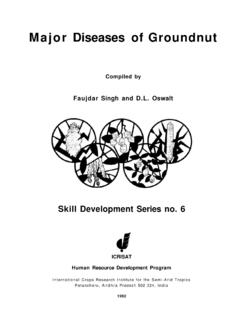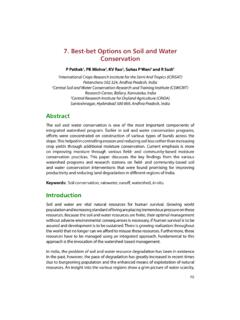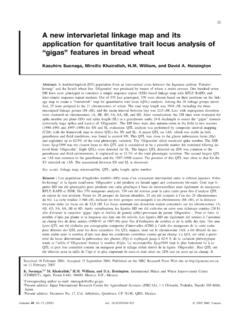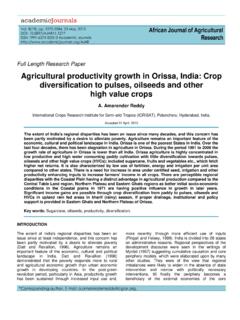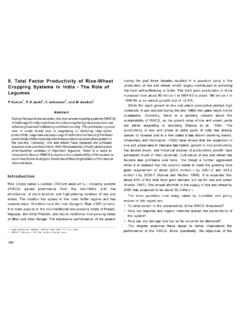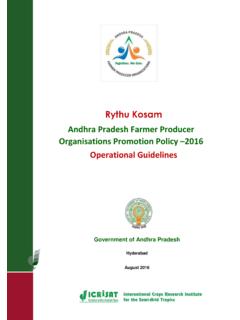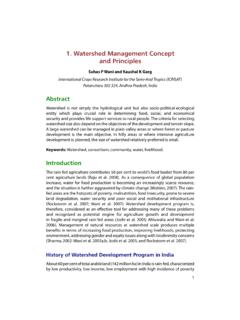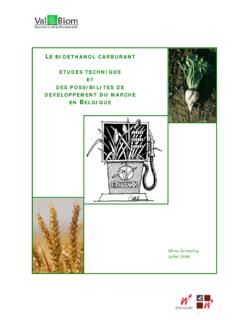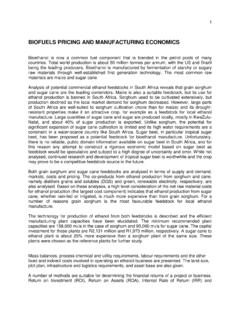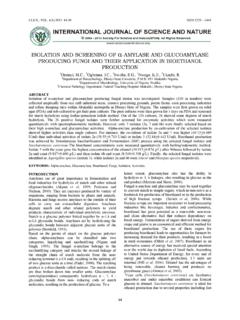Transcription of A Review of the National Biofuel Policy in India: A ...
1 Working Paper Series no. 34. RP Markets, Institutions and Policies A Review of the National Biofuel Policy in India: A critique of the Need to promote Alternative feedstocks G Basavaraj, P Parthasarathy Rao, Ch Ravinder Reddy, A Ashok Kumar, P Srinivasa Rao and BVS Reddy Patancheru 502 324, Andhra Pradesh, India 2012. About the authors G Basavaraj: Special Project Scientist; P Parthasarathy Rao: Principal Scientist; Ch Ravinder Reddy: Scientist; A Ashok Kumar: Senior Scientist; P Srinivasa Rao: Scientist; and BVS Reddy: Principal Scientist, International Crops Research Institute for the Semi-Arid Tropics, Patancheru 502 324, Andhra Pradesh, India.
2 Contents 1. 2. Energy Demand in 3. India's Biofuel 4. Policy Challenges Affecting Biofuel 5. Sweet Sorghum as an Alternative Source of Bioethanol 6. Tweaking Policies to Support Alternative 7. iii 1. Introduction Energy is a critical input for economic growth and sustainable development in both developed and developing countries. The world's energy requirement for transportation is met from non- renewable fossil fuels. The sharp rise in crude oil prices from US$20 a barrel in 2002 to almost US$100 (even touching US$140 before stabilizing at around US$80) has forced nations to seriously consider alternative energy sources that are renewable and non-polluting.
3 In the face of shrinking supplies and rising demand, oil prices are expected to continue to rise. In addition, growing concerns about human-induced climate change, as evidenced by rising temperatures and environmental pollution, are further driving the impetus for non-polluting energy sources. One such source is ethanol from plant biomass/grain and biodiesel from processing edible and non- edible vegetable oils. A mandatory 5-10% blending of biofuels with petrol and diesel stipulated by some countries in the last 10-20 years triggered a rapid growth in the Biofuel sector in the last decade. By 2007- 08, world Biofuel production had touched billion tons (t), of which around 88% was in the form of ethanol.
4 The two largest ethanol producers, Brazil and the United States of America (USA), account for almost 87% of its total production. Biodiesel production that accounts for a smaller proportion of liquid biofuels, increased from million t in 1991 to million t by 2008. The European Union (EU) produces over 60% of the global share with a significantly smaller contribution coming from the USA (17%). The key raw materials for bioethanol production are sugarcane in Brazil, corn in the USA, corn and wheat in China and molasses in India. In the case of biodiesel, the main feedstocks are vegetable oils from rapeseed, mustard, soybean, sunflower and palm oil.
5 However, the Biofuel industry is still at a nascent stage requiring Government support in terms of lower taxes and other infant industry incentives. Since raw materials for biofuels originate from the farm sector, ensuring adequate incentives for farmers to grow Biofuel crops without compromising on food security is critical. Several nations like the USA, Brazil, the Philippines, China and the European Union have in place Biofuel policies that have a bearing right from the production of Biofuel crops at the farm level to their conversion into transport grade biofuels at the distillery for use in blending.
6 This paper highlights the salient features of India's Biofuel Policy , particularly pertaining to bioethanol, and discusses how it influences the sustainability and commercialization of ethanol production in the country. In India, molasses (a byproduct of sugar production) is the main raw material for ethanol to meet the country's mandated blending requirements. The paper also addresses the long-term sustainability of ethanol production from molasses for blending mandates. Finally, the viability of using an alternative feedstock like sweet sorghum that is grown in the drylands for bioethanol production and Policy options for its promotion are explored.
7 2. Energy Demand in India India's energy demand is primarily met through non-renewable sources such as coal, natural gas and oil. These will continue to play a dominant role in its energy scenario in the next few decades. The highest demand for energy comes from industry, followed by the transportation sector which consumed about ( m of oil equivalent) of the total energy (217 million t) in 2005-06. 1. (TERI 2007). Within the transportation sector, the consumption of motor spirit (gasoline) grew by , from million t in 2001-02 to million t in 2008-09 and that of high speed diesel (HSD) by , from million t to million t (GOI 2009).
8 This growth will only escalate over the next several years since India's vehicular population is expected to grow by 10-12% per annum. Hence securing a long-term supply of energy sources and prioritizing development are critical to ensuring the country's future energy requirements are met. Currently, the country is looking for alternative energy options from biofuels to meet the transportation sector's demand. To promote biofuels as an alternative energy source, the Government of India stipulated mandatory blending requirements of gasoline with biofuels, aided by Policy incentives designed to facilitate optimal development and utilization of indigenous biomass feedstocks for Biofuel production.
9 3. India's Biofuel Policy In 1948, the Power Alcohol Act heralded India's recognition of blending petrol with ethanol. The main objective was to use ethanol from molasses to blend with petrol to bring down the price of sugar, trim wastage of molasses and reduce dependence on petrol imports. Subsequently, the Act was repealed in 2000, and in January 2003, the Government of India launched the Ethanol Blended Petrol Programme (EBPP) in nine States and four Union Territories promoting the use of ethanol for blending with gasoline and the use of biodiesel derived from non-edible oils for blending with diesel (5% blending).
10 In April 2003, the National Mission on Biodiesel launched by the Government identified Jatropha curcas as the most suitable tree-borne oilseed for biodiesel production. Due to ethanol shortage during 2004-05, the blending mandate was made optional in October 2004, and resumed in October 2006 in 20 States and 7 Union Territories in the second phase of EBPP. These ad-hoc Policy changes continued until December 2009, when the Government came out with a comprehensive National Policy on Biofuels formulated by the Ministry of New and Renewable Energy (MNRE), calling for blending at least 20% biofuels with diesel and petrol by 2017.
